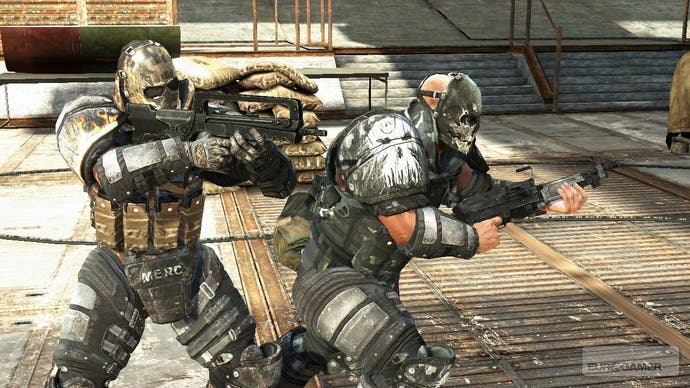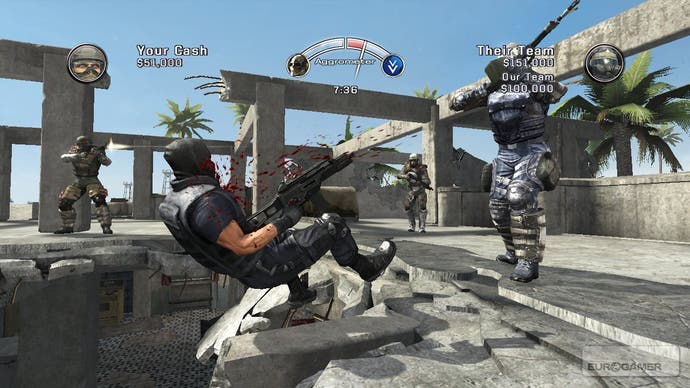Army of Two
It takes two to tango, whiskey, alpha, tango.
A few campaigns into Army of Two, and mercenaries Tyson Rios and Elliot Salem are lugging their risible body armour, pimped hand-cannons and mismatched names towards their next encounter with a bunch of insurgents who look like a street gang, in an army base that looks like a skate park, in an Iraq that looks like the outskirts of Denver. Rios (bald, scarred, The Serious One) is being Basil Exposition, wondering aloud to Salem (tousled, tattooed, The Impetuous One) whether a mole might be betraying them to the enemy.
"Don't know don't care," barks Salem, and the mindless killing begins once more.
In case you hadn't guessed from the getup that makes its supposedly macho heroes look like camp, sado-masochistic, medieval ice hockey goalies, Army of Two doesn't take itself all that seriously. This co-op-focused, third-person shooter is no Tom Clancy's Advanced Military Anorak Fantasy. Why are we killing these men? What's the plot again? Which third-world country are we blowing up next? Don't know, don't care. In the middle of one firefight, Salem starts banging on about who the best rapper in the Wu-Tang Clan is. It's practically self-parody.

It's a good thing, too. The light tone helps you get past the drab locations, dodgy politics, dumb machismo, clumsy dialogue and production-line plot of this superficially standard action game, and focus on what it does well: tactical AI, weapon customisation and superb two-player co-op dynamics.
For all that it revels in shooter cliché, the fact that Army of Two was designed from first principles for two players makes it quite an unusual beast. The core of this is the "aggro" system that splices the cover-and-flank tactics of a squad shooter with the threat management mechanics of an MMORPG, and then telegraphs it to the player with all the subtlety of a sucker punch. When one of the pair of "private military contractors" is shooting at the enemy, he draws their fire and glows red. His partner fades to transparency and can move to a flanking position unmolested, the better to take out the enemies behind cover, in body armour, or at machinegun posts. Or to not die, if he's the one under fire already (a "feign death" move also allows you to instantly drop aggro when your health is low).

As if the visual cues weren't easy enough to understand, there's an aggro meter at the top of the screen, showing you where things stand. It might seem like overkill, but the absolute clarity of the aggro system is Army of Two's greatest strength. It makes it supernaturally easy to fall into the game's steady, swinging rhythm, and means that EA Montreal has been able to notch enemy behaviour a few levels above blind and brain-damaged without making the game frustrating to play. Your opponents frequently attack from two sides and use cover properly, blind-firing and falling back when threatened - but since they can always be outsmarted and outflanked by using the aggro system, you've always got options.
The game is best enjoyed by far with another player, and supports split-screen play as well as a robust drop-in drop-out mode over Xbox Live or PSN. But the AI that takes control of your partner when you play alone is surprisingly capable, too. It's not that it's outstandingly clever, believable or error-free - rather that the command system is elegant and effective, with directions on the d-pad allowing you to toggle between passive and aggressive versions of advance, regroup, and hold-position. Between this and the aggro system, it's simplicity itself to manipulate the AI to get you out of thorny situations.



